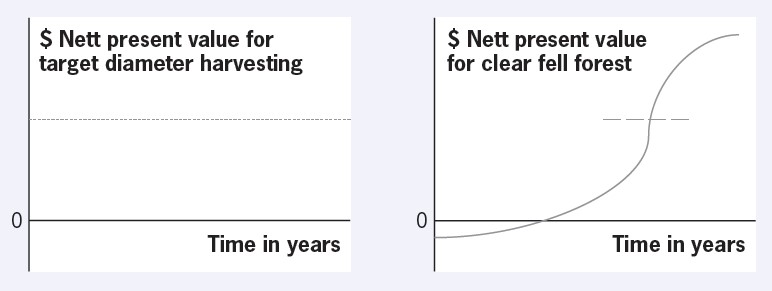Target diameter harvesting – beyond the transition
Howard Moore, New Zealand Tree Grower May 2019.
The short paper on target diameter harvesting in February’s Tree Grower was supplemented by the excellent field day at Tinui Forest Park in the Wairarapa, where around 45 people turned up to hear the authors and researchers enlarge on their work. Several things not covered in the paper became clearer with the handouts and discussion, and this one I thought was worth recording.
Naturally the research was aimed at informing existing forest growers who had single age-class stands. All of the scenarios therefore assumed that someone who had planted, intending to clear fell later, might switch to continuous cover forestry. Clear fell, of course, removes big and small trees, whereas target diameter harvesting leaves small trees until they grow big enough to fell. Obviously, that takes time, income is deferred, and so target diameter harvesting appears less profitable. But this just models the transition and does not give the full picture. In steady state, a continuous cover forest would have mixed age classes, and a clear fell one would not. In that situation, what would the relative profitability look like?
In broad terms, under target diameter harvesting, a mixed age forest would operate like a normal forest a forest with equal areas of each age class, with the oldest age class harvested each year. It would generate a steady income each year with a constant nett present value. The comparable clear fell forest would generate a rotational income. Its nett present value would follow an S curve, from negative immediately after harvest, when costs were imminent and revenue decades away, to high immediately before harvest when revenues were imminent. Clearly, until that S curve rose to cross the straight line of the alternative regime, the net present value of the clear fell forest would be lower than that of its target diameter harvest equivalent.

Viewed in this way, net present values are equivalent to expectation values as used in the research. One might argue the accuracy of my sketches, but the fact remains that based on discounted cash flows, in steady state a continuous cover forest would, at times, appear more profitable than an equivalent single age-class clear fell forest. The earlier Tree Grower article did not make that clear, and risked giving the wrong impression.
A response to Howard Moore’s comments from Chris Perry
I understand where Howard is coming from. Yes, if comparing the two systems for a multi-age forest a target diameter harvesting or continuous cover system may prove more profitable than clear fell − I do not know. That is not the situation we are in, and I would argue that if we already had multi-age forests clear fell would not even get a look in regardless of economics – it would just not make sense to clear fell a multi-age class forest.
The situation we are in, and that is posing a potential problem for the industry, is that we have enormous areas of single age-class forests with a growing question mark over their suitability to clear fell. Therefore, the question is how does a clear fell and replant compare with a target diameter conversion to a mixed-age class forest. Or what is the economic sacrifice of converting mono-age class forests into continuous cover multi-aged systems.
Unfortunately, discounted cash flow analysis is the standard for assessing forest economic performance.
There is cost, both actual and opportunity costs of the land, associated with a forest reaching maturity. To write off that cost when deciding at age 18 or 20 might make sense to some land owners, but when comparing economic performance between the two systems it cannot be ignored.
There were some comments about comparing target diameter harvesting and clear fell from year zero in the establishment phase. I do not see any benefit to this because under our conventional plantation regimes the cost of establishing a forest for clear fell or target diameter harvesting will be the same or similar. Once the asset is established at say 18 years, the forest owner then has a choice how he treats that asset. The decision to go target diameter harvesting or clear fell does not need to be made any earlier. So I think our comparison is a fair and real one as it represents the situation many forest owners are in who may consider target diameter harvesting.

 Farm Forestry New Zealand
Farm Forestry New Zealand